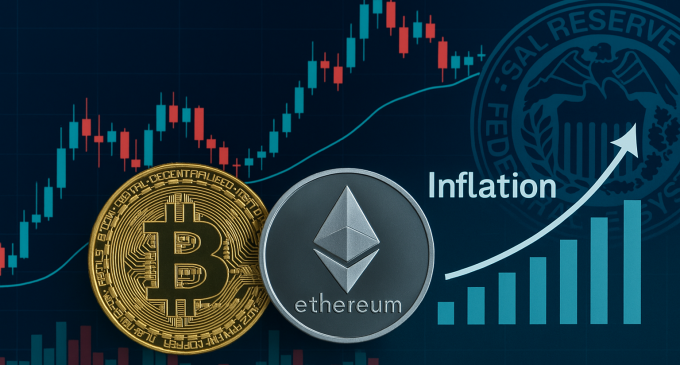
Introduction
As global financial markets continue to respond to a mix of inflationary pressure, interest rate expectations, and monetary policy decisions, the crypto market is gearing up for a particularly pivotal week. All eyes are now on the upcoming release of the US Personal Consumption Expenditures (PCE) inflation data and the minutes from the Federal Open Market Committee (FOMC) meeting—both of which are expected to offer key insights into the Federal Reserve’s stance on future interest rate moves. For cryptocurrencies like Bitcoin (BTC) and Ethereum (ETH), this could mean a period of heightened volatility, as investors react in real-time to shifts in macroeconomic sentiment.
Understanding The US PCE Inflation Data
The Personal Consumption Expenditures (PCE) price index is one of the Federal Reserve’s preferred metrics for gauging inflation. Unlike the Consumer Price Index (CPI), which looks at out-of-pocket expenditures by urban consumers, PCE offers a broader measure of spending and is considered more comprehensive because it adjusts for changes in consumer behavior and substitutions.
The upcoming core PCE data—which excludes volatile food and energy prices—is set to be released later this week. Economists and investors alike are watching closely because this data could reinforce or alter the current trajectory of the Fed’s monetary policy decisions. If inflation comes in higher than expected, the Fed may keep interest rates elevated for a longer duration. Conversely, weaker inflation data may pave the way for earlier rate cuts, fueling risk appetite in speculative assets—including cryptocurrencies.
For crypto traders, PCE data has become increasingly influential. In the past year, we have seen how surprising CPI or PCE figures can spark either bullish or bearish movements in the digital asset space, with Bitcoin’s price sometimes swinging thousands of dollars within hours of the release.
Why Do The FOMC Minutes Matter For Crypto Investors?
While inflation data gives investors a snapshot of economic health, the FOMC meeting minutes provide a window into the minds of the Fed policymakers. These minutes are a detailed account of the discussions that took place during the latest policy meeting, offering more nuanced insight than the initial post-meeting press conference.
Crypto investors often comb through these minutes for any language that suggests shifts in the Fed’s sentiment regarding inflation risks, economic growth projections, and interest rate timelines. Given that Bitcoin and Ethereum have increasingly traded like risk-on assets—often mirroring the behavior of tech stocks—Fed language that hints at dovishness (a tilt toward rate cuts) tends to spur crypto rallies. Conversely, hawkish tone (favoring higher interest rates) can result in selloffs.
This week’s minutes will be closely scrutinized to understand whether the Fed views recent inflation data as persistent or transitory, and whether internal divisions are emerging among policymakers about the path forward. Traders expect volatility to spike around the release, as algorithms and high-frequency traders respond instantly to perceived changes in the Fed’s tone.
Current State Of The Crypto Market
As of late May 2025, the cryptocurrency market is exhibiting signs of cautious optimism. Bitcoin is currently trading in a relatively tight range between $66,000 and $70,000, while Ethereum hovers near $3,400 to $3,700. Trading volumes are down slightly from the earlier part of the year, a reflection of the market’s wait-and-watch approach ahead of key macroeconomic catalysts.
Several factors are currently influencing sentiment:
Institutional Accumulation: Recent data from on-chain analytics platforms shows that institutional wallets are accumulating Bitcoin, suggesting growing confidence in the asset’s long-term value proposition, even amidst short-term uncertainty.
ETH ETF Speculation: Hype around the potential approval of a spot Ethereum ETF in the United States has injected renewed momentum into ETH’s price. Market participants believe that, following the success of Bitcoin ETFs, Ethereum could be next in line, opening the doors for wider adoption.
Altcoin Rebound: While Bitcoin and Ethereum dominate headlines, altcoins such as Solana, Avalanche, and Chainlink have shown moderate rebounds, suggesting that risk appetite is tentatively returning among retail investors.
However, most analysts agree that macro uncertainty remains the dominant force, and upcoming inflation and FOMC data will act as the deciding factors for near-term price direction.
Bitcoin’s Technical Outlook Ahead Of Economic Events
From a technical perspective, Bitcoin remains in a consolidation phase, but is forming a pattern that resembles a bullish pennant—a continuation pattern that often precedes upward moves. Key resistance lies at $71,500, while immediate support is found near $65,200.
If the PCE inflation data surprises to the downside, Bitcoin could break out of its current range and attempt to retest the $74,000 to $75,000 zone. On the flip side, if inflation proves sticky and Fed minutes come off as hawkish, BTC could fall below its current support levels and test $62,000 or lower.
Short-term traders are closely watching the Relative Strength Index (RSI), which remains neutral, and the Moving Average Convergence Divergence (MACD), which is signaling a possible bullish crossover—suggesting momentum might shift in the coming days.
Ethereum’s Outlook: ETF Buzz Vs. Macro Headwinds
Ethereum’s price trajectory is influenced not only by macroeconomic factors but also by project-specific catalysts, such as ETF-related developments and network upgrades.
In the short term, ETH appears to be forming a descending triangle, which can either lead to a breakout or breakdown depending on external triggers. Support is firm around $3,300, with resistance near $3,800.
If the macro data favors risk assets, Ethereum could climb toward $4,000, especially if ETF speculation intensifies. On the contrary, hawkish FOMC minutes could pressure ETH prices, potentially pushing them back toward $3,000.
It’s worth noting that Ethereum’s network activity is on the rise, with increasing transactions, higher NFT engagement, and renewed interest in staking—all of which support its fundamental value proposition.
Market Sentiment And Institutional Insights
Beyond charts and data, understanding sentiment can provide a crucial edge. Recent surveys among institutional traders show a 50/50 split on whether the Fed will cut rates this year, highlighting the current uncertainty.
Notably, BlackRock, Fidelity, and ARK Invest have all maintained exposure to crypto-related products in their portfolios, signaling long-term confidence. Additionally, CME futures open interest in Bitcoin has increased, suggesting that professional traders are positioning themselves for a move.
Fear and Greed Index, a popular sentiment indicator in crypto, currently hovers at a neutral 52, suggesting that traders are neither overly bullish nor bearish—but poised to act based on this week’s economic data.
What To Expect: Volatility And Potential Scenarios
Here are some potential scenarios and their likely impact on the crypto market:
Scenario 1: Lower PCE and Dovish FOMC Minutes
Expected Market Reaction: Bullish
Bitcoin Target: $74,000+
Ethereum Target: $4,000+
Narrative: Inflation easing, Fed may start discussing rate cuts.
Scenario 2: Higher PCE and Hawkish FOMC Minutes
Expected Market Reaction: Bearish
Bitcoin Target: $62,000 or lower
Ethereum Target: $3,000 or lower
Narrative: Inflation remains sticky, Fed could delay rate cuts.
Scenario 3: Mixed Data
Expected Market Reaction: Sideways / Range-bound
Bitcoin Target: $66,000 to $69,000
Ethereum Target: $3,400 to $3,700
Narrative: Conflicting data leads to indecision.
Long-Term Implications For Crypto Adoption
Beyond short-term price movements, macroeconomic developments like PCE inflation and FOMC minutes play a growing role in shaping long-term narratives around cryptocurrencies.
Digital Assets as Macro Hedge: While Bitcoin was once considered immune to macro data, the narrative is evolving. BTC is increasingly seen as a hedge against currency debasement and long-term inflation.
Integration With Traditional Finance: The rise of spot ETFs and institutional interest is gradually blending traditional finance with crypto, making macro data more relevant than ever to digital asset investors.
Policy-Driven Cycles: As regulatory clarity improves and interest rate cycles stabilize, crypto may continue to solidify its position in diversified portfolios, particularly as a non-correlated or alternative asset.
Conclusion
As the crypto market awaits the release of US PCE inflation data and the FOMC meeting minutes, investors are bracing for a potential surge in volatility. The outcomes of these releases will not only influence short-term price direction for Bitcoin and Ethereum but also shape broader sentiment across the digital asset space.
Traders, institutional players, and retail investors alike will be watching closely. Whether the data signals relief from inflation or reinforces the Fed’s cautious stance, one thing is clear: crypto has become deeply intertwined with the broader macroeconomic narrative, and understanding these dynamics is more essential than ever.







There are no comments at the moment, do you want to add one?
Write a comment